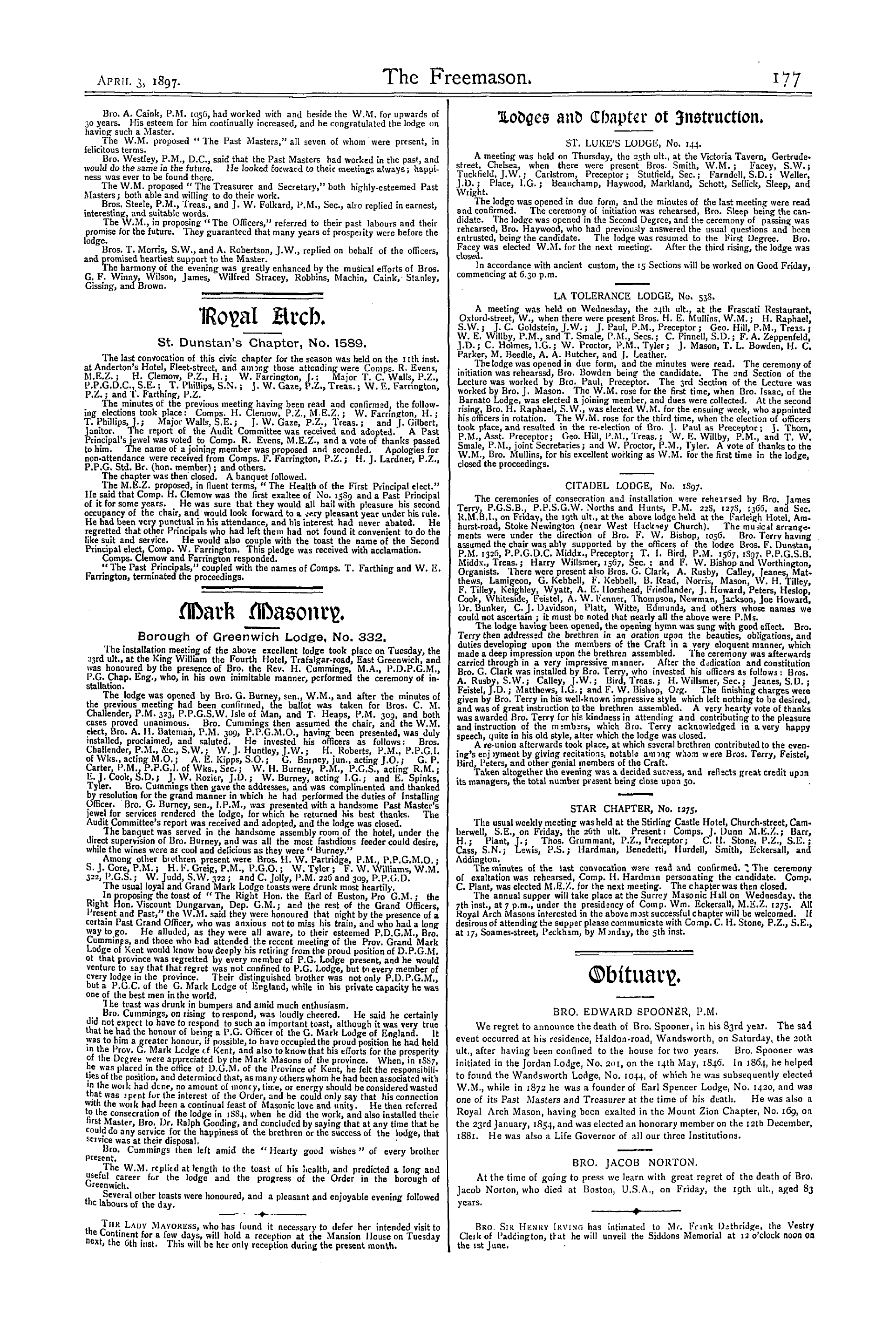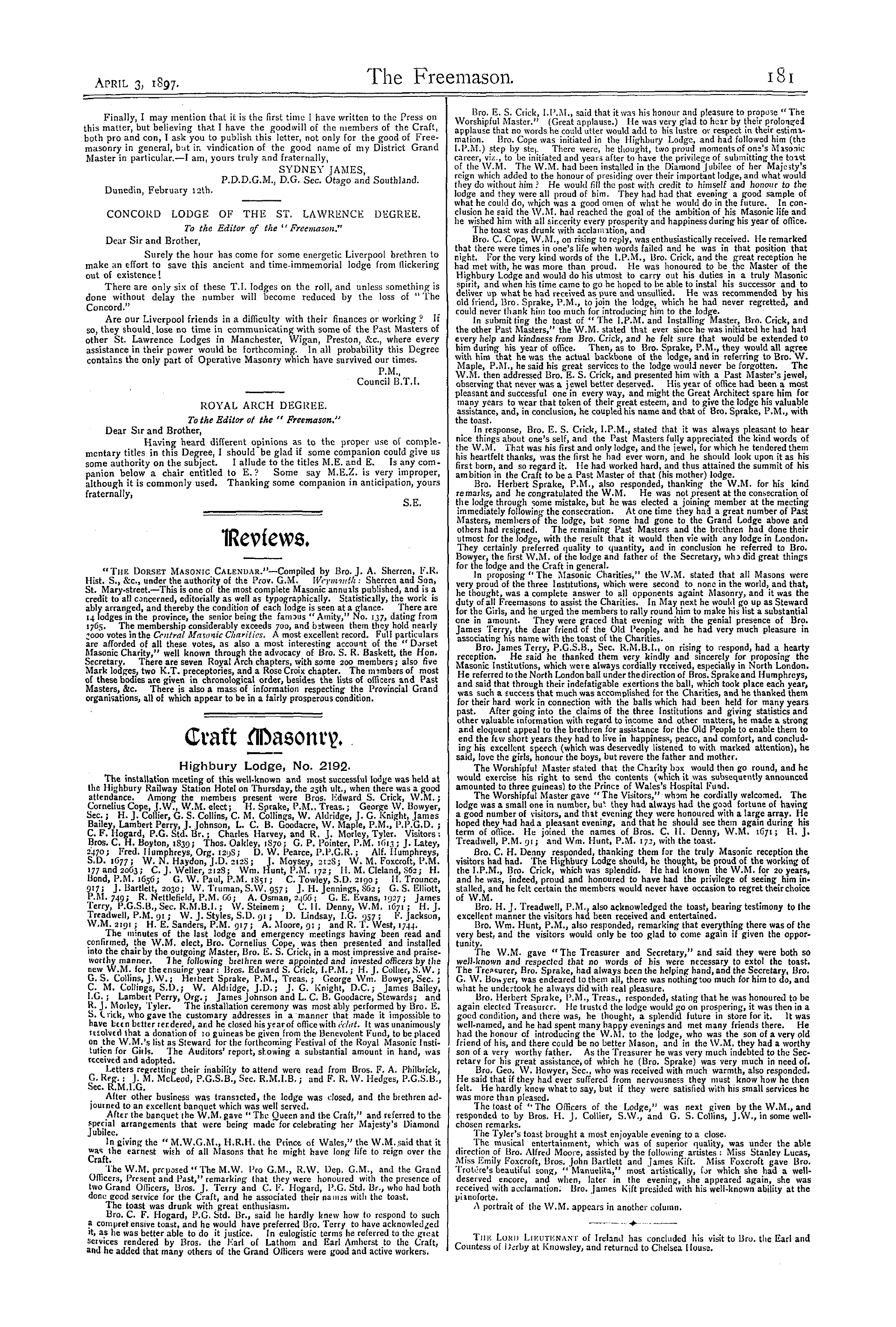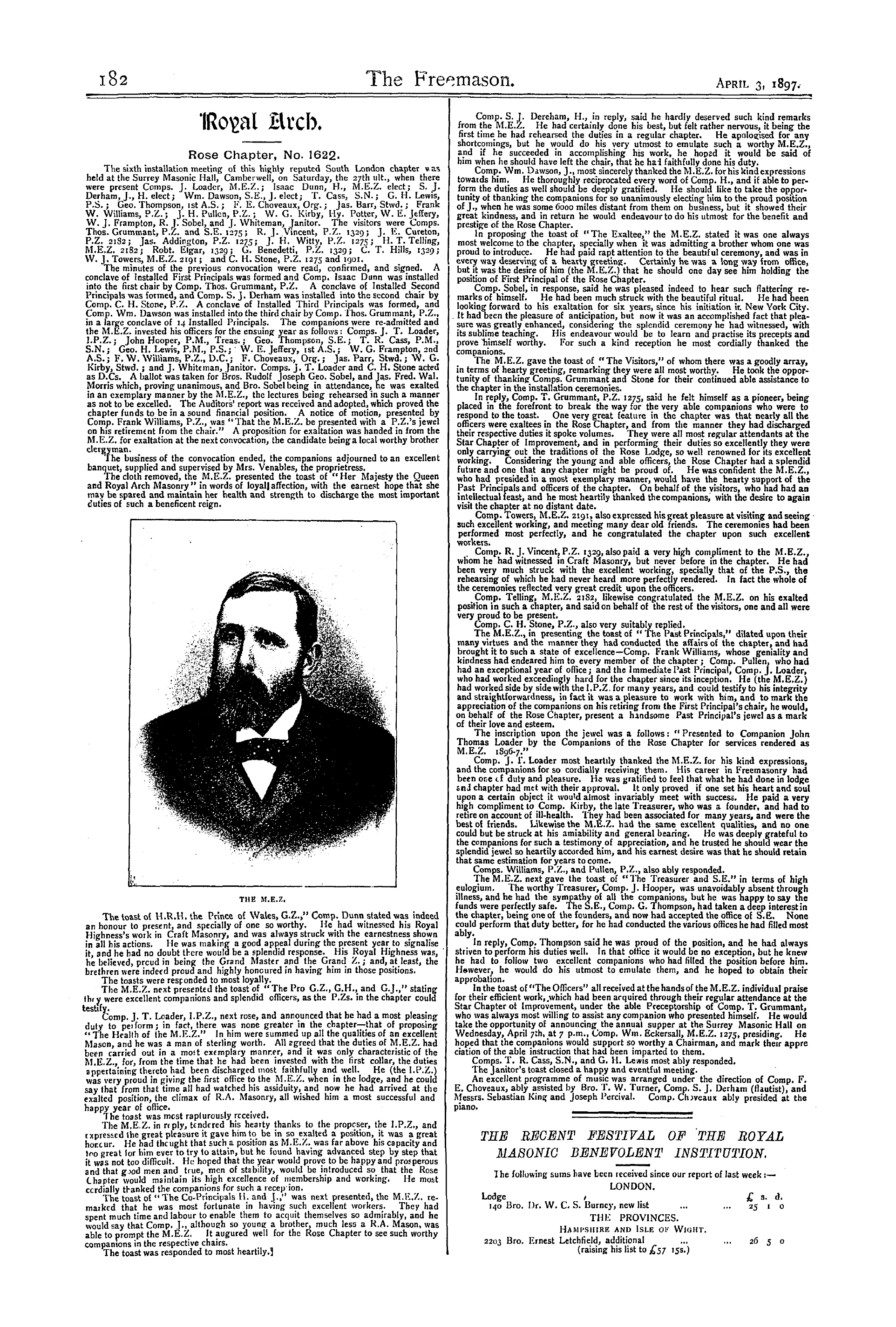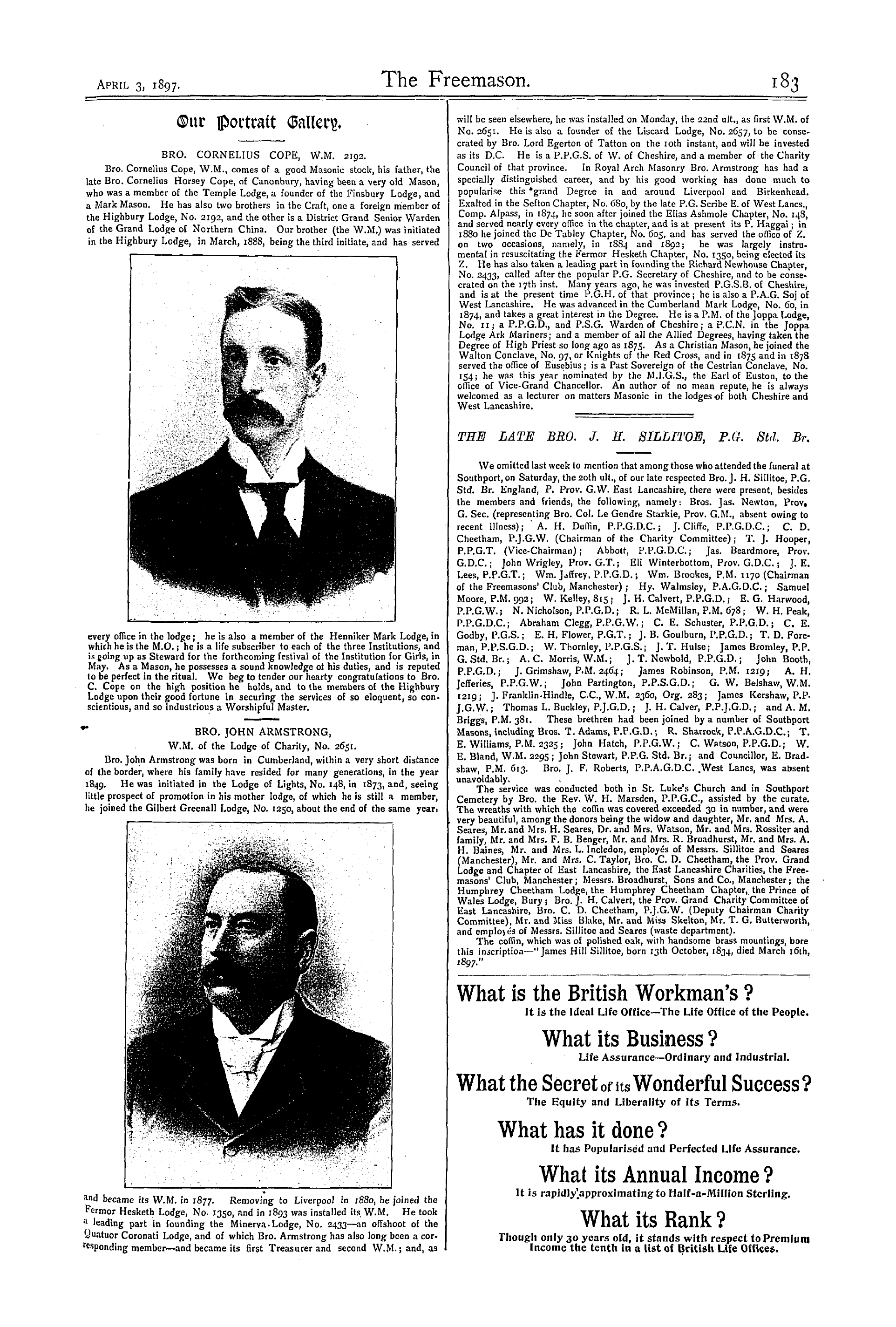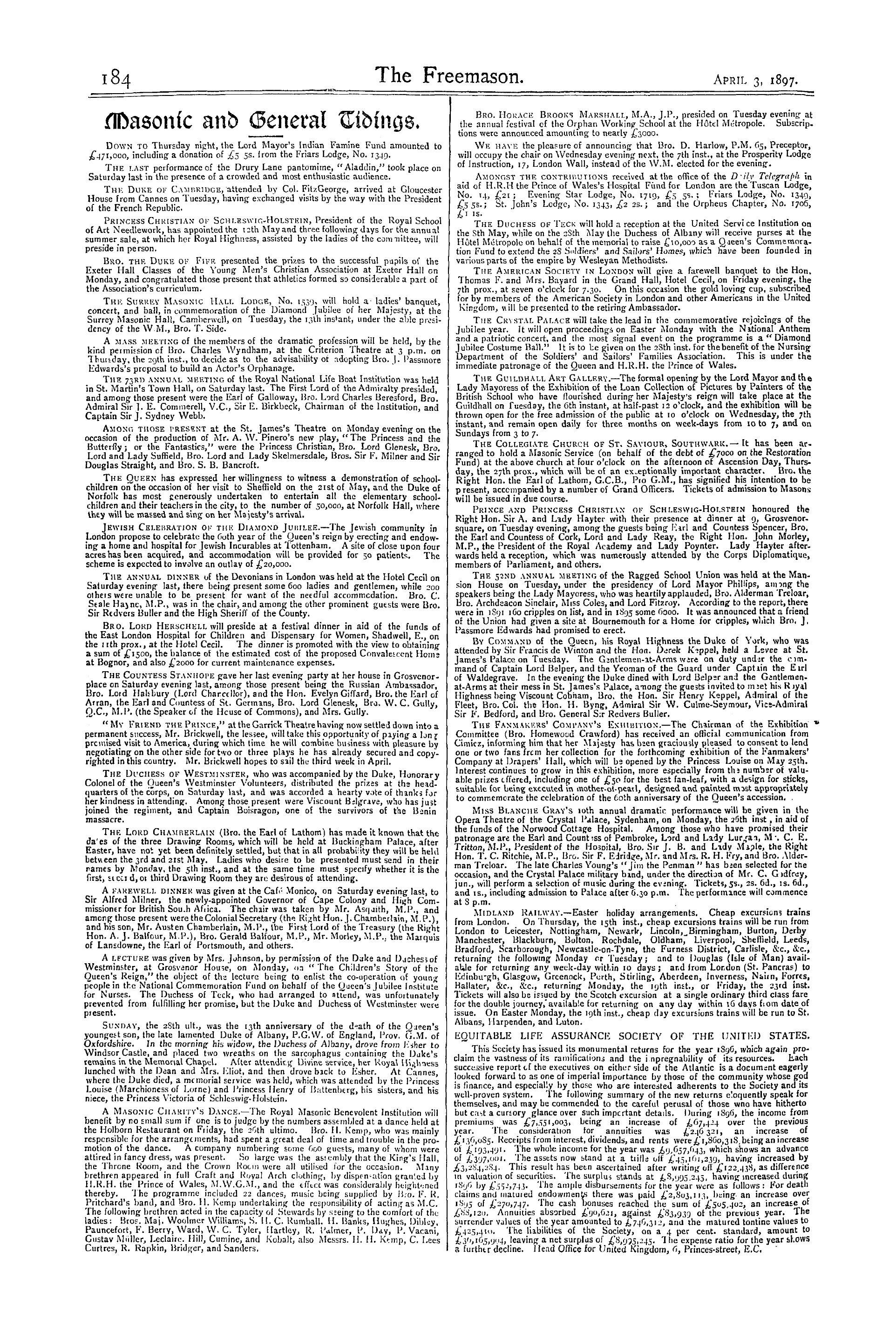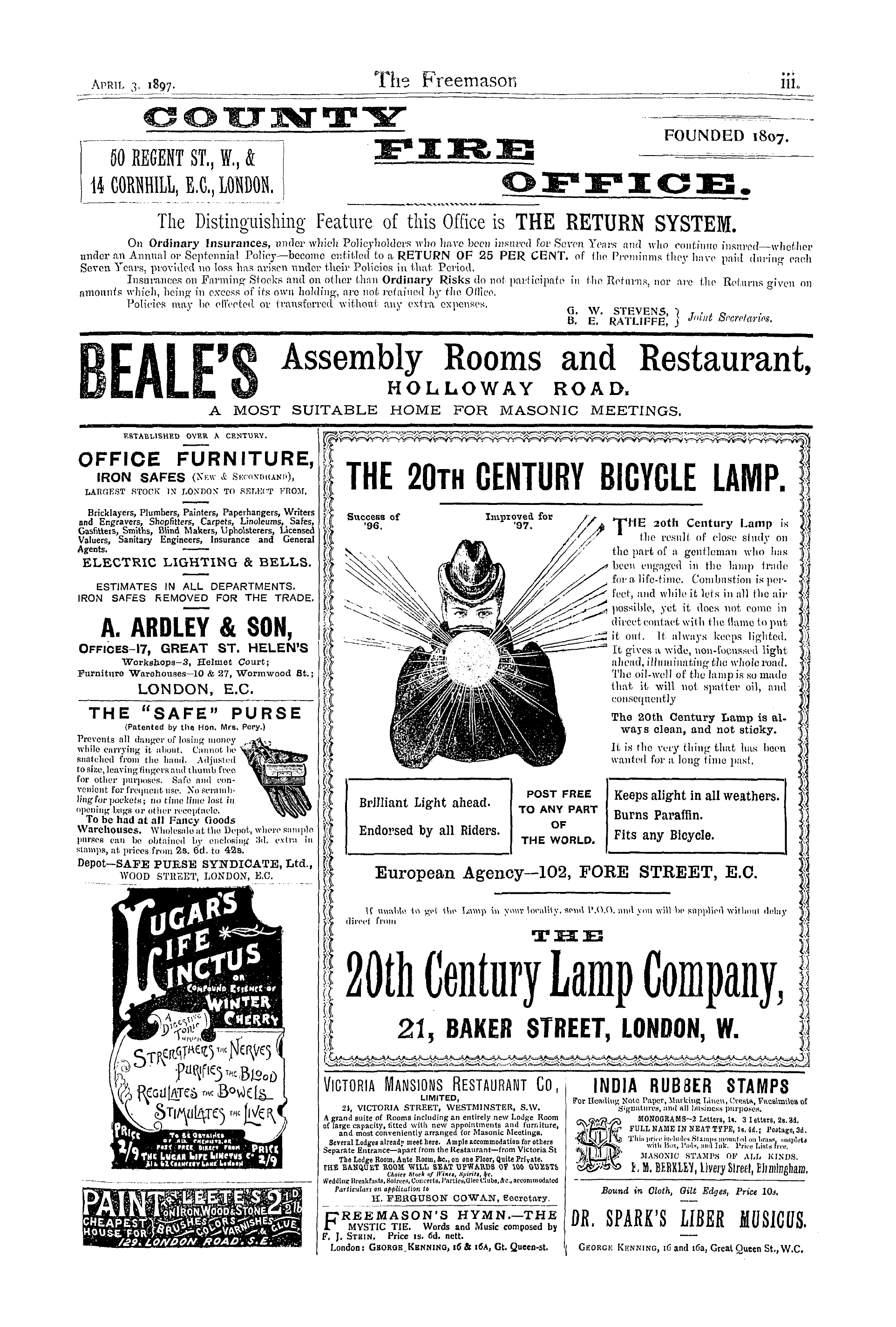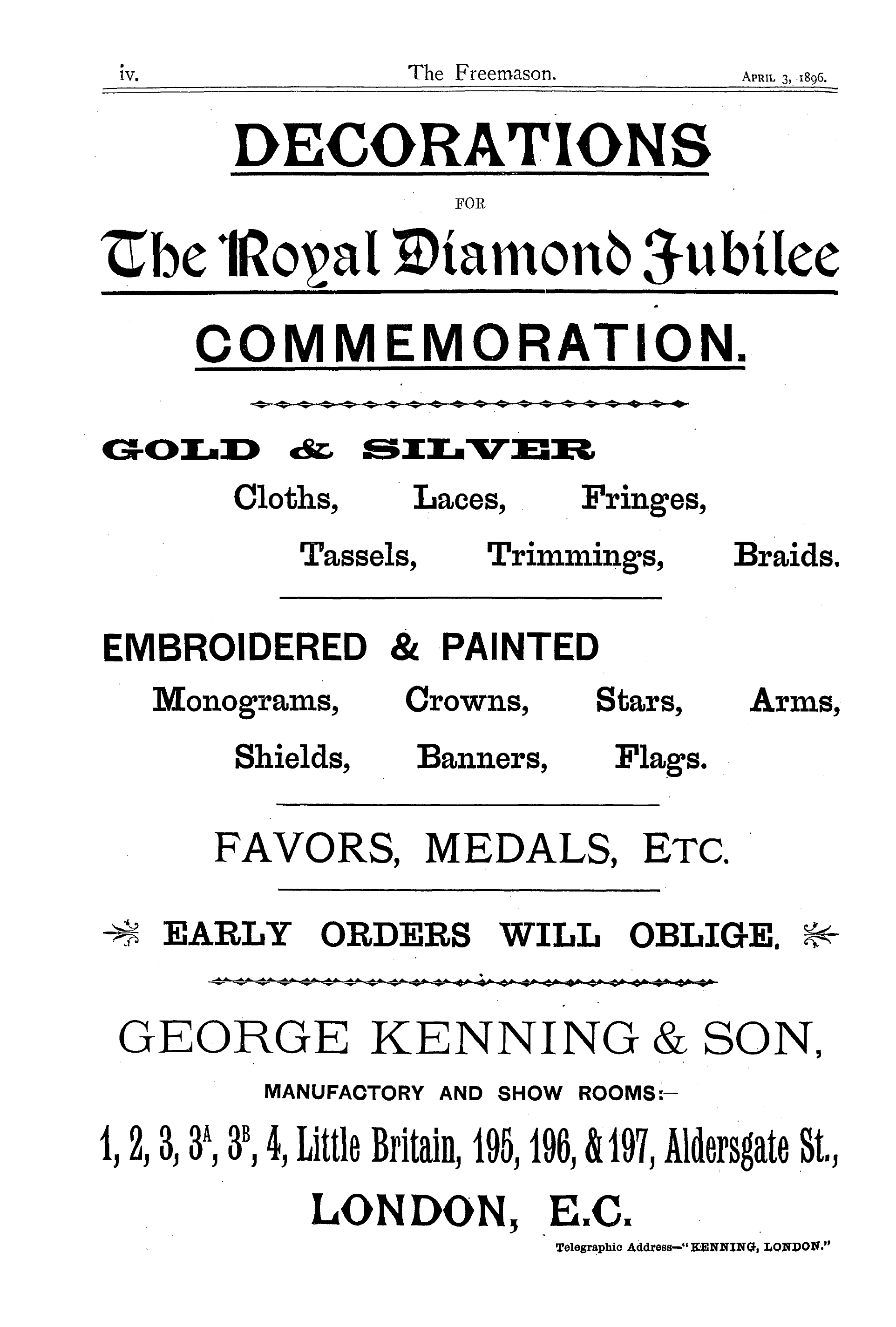-
Articles/Ads
Article CÆMENTARIA HIBERNICA.* Page 1 of 1 Article CÆMENTARIA HIBERNICA.* Page 1 of 1 Article THE "STABILITY" LODGE, No. 217, LONDON. Page 1 of 1
Note: This text has been automatically extracted via Optical Character Recognition (OCR) software.
Cæmentaria Hibernica.*
C ? MENTARIA HIBERNICA . *
In our article of last week on the second section of Bro . CRAWLEY ' S work , we remarked on his important discovery of the existence of the Grand Lodge of Ireland some few years earlier than the date ordinarily assigned to its foundation . But
the account of this discovery is rendered additionally interesting by the information which Bro . CRAWLEY has gathered from various sources concerning the principal personages mentioned in the excerpt from the Dublin Weekly Journal .
firstly , as regards the Earl of ROSSE , who , as we have seen , was elected Grand Master on St . John the Baptist's Day , 1725 , the one or two anecdotes that are quoted of him fully bear out the description that he was " the wildest and most dissolute among
the wild and dissolute gallants of the Irish Metropolis . " He had " the reputation of being the most finished libertine within the four seas . But his high intellectual and social g ifts lifted him above the level of his companions' dull debauchery . What with
them was the practice of coarse excess , became with him almost the exercise of a fine art . " But , though devoting his whole life to the pursuit of pleasure , he still found time to become " an active patron of tine art , " and , what is still more to his credit ,
there must have been something eminently attractive in his lordship , when we are told by Bro . CRAWLEY that the satirists spared him , and that he has not met in contemporary literature " with a single personal attack on him of the kind which was
wont to assail all public characters of the day , from the Viceroy down to GEORGE FAULKNER , the printer . Even the stories that were told of his lordship betray a touch of sympathy in the telling . " There are two stories narrated of " the Earl's witty
perversity " under the exhortations which were showered upon him by the clergy during his mortal illness ; but for these we must refer the reader to the Fasciculus itself . As regards the other Grand Officers , Sir THOMAS PRENDERGAST , whom the
Grand Lodge elected S . G . W ., was M . P . for Chichester in the English , and for Clonmel in the Irish , House of Commons , and Postmaster-General of Ireland . As a Mason , he was a member of the Old Horn , Westminster , Time Immemorial
Lodge—present No . 4—the aristocratic London lodge of the day , and having been elected S . G . W . of Ireland on St . John the Baptist ' s Day , I 725 , was on the following St . John the Evangelist's Day ( 27 th December ) appointed J . G . W . of England .
" Thus , " as Bro . CRAWLEY points out , " Sir THOMAS PRENDERGAST had the honour of serving as Grand Warden simultaneously in the only two Grand Lodges then in existence . " Bro . MARK ANTHONY MORGAN , of Cottlestown , Co . Sligo , and of Cork
Abbey , near Bray , Co . Wicklow , who was appointed J . G . W ., was also a prominent public man . He took his degree as B . A . at Trinity College , Dublin , in 1721 , and sat in the Irish House of Commons for the borough of Athy ; but , though a prominent ,
he was very far from being a popular , personage , and brought himself under the lash both of Bro . JAMES STERLING , who is mentioned in a later portion of the Fasciculus , and of Dean SWIFT . Bro . the Hon . HUMPHREY BUTLER , whom Lord ROSSE
appointed his Deputy , was the eldest son of BRINSLEY BUTLER , second baron of Newtown Butler , who was created Viscount L 4 NESBOROUGH in 1728 , and was himself advanced a step in the peerage , being created Earl of L-A . NES
BOROIT . H in 175 6 . Bro . THOMAS GRIFFITH , Grand Secretary , had a high reputation as a " representative of the lighter comedy , " and was a successful vocalist as well as actor . " His popularity induced Lord Soi'THWELL in 17 . 0 to procure for
him a post in the Revenue , which he enjoyed till his death "in 1743— " discharging his duties by deputy . " In his early days he played at Drury Lane with BET'TERTON , and in his later numbered QuiN among the youthful members of his company .
This Bro . GRIFFITH IS mentioned in a passage which Bro CRAWLEY quotes in his Fasciculus I . as having been Secretary of the Grand Lodge of Ireland , and what renders ihe passage quoted of still greater value is that the Grand Lodge of J 729-30 is distinctly spoken of as a " revival . "
Cæmentaria Hibernica.*
The next section of Fasciculus II . treats of " Bro . WILLIAM SMITH and the Masonic Manuals of 1735-6 , " and is preceded , as in the case of the other sections , by an Introduction , in which any particulars of especial importance are noted and freel y
commented upon . The Manuals are three in number , namely , the Pocket Companion , published in Dublin in 1735 ; the Pocket Companion , issued , almost simultaneously , in London for the use of English Freemasons ; and " The Book M , issued at New .
castle-on-Tyne , in 1736 , for the use of Freemasons in the North of England . " As regards these , Bro . CRAWLEY points out that they " present differences in detail , but are substantially identical in legislation and dogma . " This identity fully justifies
the author ' s conclusion that " at the time they were published there was no appreciable difference in the work of the three Grand Lodges of Dublin , London , and York . The very care which introduced minor changes to fit the books for their several
audiences is the strongest proof that there were no major differences . " This opinion is , we suggest , corroborated b y the list of works quoted by LAURENCE DERMOTT in a letter—for which he was censured by the Grand Lodge of the "Antients " in
London—as being authorities for the guidance of the Antient Craft in their practice of Masonry—the works in question being ANDERSON ' S Constitutions , 1738 ; DASSIGNY ' S work of 1744 ; SPRATT ' s Constitutions , 175 1 ; and DERMOTT ' own " Ahiman Rezon " of
the years , 1756 , 17 6 4 , 177 8 . But we must reserve our further remarks for a third article , in which we trust we shall be able to bring the consideration of this further instalment of Bro . CRAWLEY ' work to a conclusion .
The "Stability" Lodge, No. 217, London.
THE "STABILITY" LODGE , No . 217 , LONDON .
This is the age of Lodge Histories , which is much to the advantage of the Craft generally and to the members of the favoured lodges in particular . Every now and then sketches of old lodges are being written , or more elaborate publications are being produced , the result baing that an immense mass of most valuable and deeply interesting information respecting the
usages and customs of our Masonic forefathers , has been accumulated of late years , enabling us to be more in touch with the brethren of the last century than ever before . A fresh candidate for our study and consideration has just appeared , compiled by Bro . William Robert Smith , P . M ., the lodge thus described being that of the " Stability , " No . 217 , which completed its first 100 years of existence on March 1 st , 1897 .
The History is not an elaborate work , but simply a brief account of the chief events during the century , especially in relation to the " most illustrious Mason connected with Stability Lodge , viz . Bro . Philip Broadfoot , who was initiated July 3 rd , 1810 . " The book has really been " a product of accidental circumstances , " having grown to its present size " as the materials opened out in amount and importance , " and 1 entirely sympathise with the
painstaking author in his wish that " this book may stimulate others to search into the great mine of Masonic History , and glean grain profitable to their mother lodge and the Fraternity at large . " Bro . Smith gives a copy of the original warrant ( still preserved ) of March , 1 st , 1797 , granted by the Duke of Atholl , Grand' Master of the " Ancients , " its number then , and to the blessed Union of December , 1813 , being 300 . There were eight founders , three of whom—the W . M . and
Wardens—are recorded on the Charter . A number of interesting particulars are noted concerning these worthies , mainly traced by Bro . Henry Sadler , to whom neatly all Lodge Historiansare considerably indebted , who is warmly thanked accordingly . Bro . Gould ' s handy little volume on the " Atholl Lodges , " and Bro . Kenning ' s " Illustrated History of the Lion and Lamb Lodge , " written by me , are also duly credited for information from their pages .
The lodge has had many places of meeting , 23 in all , and beginning at the Crown , near St . Dunstan * s Church , Fleet-street , it wandered to numerous parts of the City , until the members have again returned to the same wellknown street , and rest now at Anderton ' s Hotel . There have only been seven Treasurers , and as many Secretaries through the 100 years , Brothers John Dixon and SamutI Powell Fisher holding these offices now , respectively , and as Bro . Smith observes , " We hope tor very many years . "
A Table exhibits the numerical progress from 1797 , and happily , now , during its centenary ) ear , it is active , united , and prosperous . The lodge , foA-evcr , has a name that will last , quite apart from even its own personal history , because of the founding ot the famous Lodge of Instruction working under the sanction of the '" Stability" Lodge , by
Brothers Peter Thompson and Philip Broadfoot . The latter took the Chair as W . M . at the first meeting held on the first Friday in February , 1817 ; so it is the oldest Lodge of Instruction in the Metropolis . Bro . Henry Muggeridge was the successor of Bro . Thompson , and again we are in sympathy with Bro . Smith in his wish that cur dear " Old Mug " may jet be spared to his dear ones for years to come .
The numerous items of information regarding many of the early members are deeply interesting , and make most entertaining reading . Bro . Smith's fondness for his lodge is rightly and clearly exhibited almost on every page , so that it is pleasantly written and in a very happy vein . 1 congratulate the lodge on possessing such an enthusiastic and
competent Historian , also on the Centenary J ; wel Warrant being granted , and on the vigorous and healthy condition of the lodge . Brethren who want to know more about No . 217 cannot do better than apply for copies , 2 s . each , from the Printers , Messrs . Lawrence and Symcox , Hall's-yard , Sardiniaplace , Lineoln ' s-Inn-Fields . W . J . HUGHAN .
Note: This text has been automatically extracted via Optical Character Recognition (OCR) software.
Cæmentaria Hibernica.*
C ? MENTARIA HIBERNICA . *
In our article of last week on the second section of Bro . CRAWLEY ' S work , we remarked on his important discovery of the existence of the Grand Lodge of Ireland some few years earlier than the date ordinarily assigned to its foundation . But
the account of this discovery is rendered additionally interesting by the information which Bro . CRAWLEY has gathered from various sources concerning the principal personages mentioned in the excerpt from the Dublin Weekly Journal .
firstly , as regards the Earl of ROSSE , who , as we have seen , was elected Grand Master on St . John the Baptist's Day , 1725 , the one or two anecdotes that are quoted of him fully bear out the description that he was " the wildest and most dissolute among
the wild and dissolute gallants of the Irish Metropolis . " He had " the reputation of being the most finished libertine within the four seas . But his high intellectual and social g ifts lifted him above the level of his companions' dull debauchery . What with
them was the practice of coarse excess , became with him almost the exercise of a fine art . " But , though devoting his whole life to the pursuit of pleasure , he still found time to become " an active patron of tine art , " and , what is still more to his credit ,
there must have been something eminently attractive in his lordship , when we are told by Bro . CRAWLEY that the satirists spared him , and that he has not met in contemporary literature " with a single personal attack on him of the kind which was
wont to assail all public characters of the day , from the Viceroy down to GEORGE FAULKNER , the printer . Even the stories that were told of his lordship betray a touch of sympathy in the telling . " There are two stories narrated of " the Earl's witty
perversity " under the exhortations which were showered upon him by the clergy during his mortal illness ; but for these we must refer the reader to the Fasciculus itself . As regards the other Grand Officers , Sir THOMAS PRENDERGAST , whom the
Grand Lodge elected S . G . W ., was M . P . for Chichester in the English , and for Clonmel in the Irish , House of Commons , and Postmaster-General of Ireland . As a Mason , he was a member of the Old Horn , Westminster , Time Immemorial
Lodge—present No . 4—the aristocratic London lodge of the day , and having been elected S . G . W . of Ireland on St . John the Baptist ' s Day , I 725 , was on the following St . John the Evangelist's Day ( 27 th December ) appointed J . G . W . of England .
" Thus , " as Bro . CRAWLEY points out , " Sir THOMAS PRENDERGAST had the honour of serving as Grand Warden simultaneously in the only two Grand Lodges then in existence . " Bro . MARK ANTHONY MORGAN , of Cottlestown , Co . Sligo , and of Cork
Abbey , near Bray , Co . Wicklow , who was appointed J . G . W ., was also a prominent public man . He took his degree as B . A . at Trinity College , Dublin , in 1721 , and sat in the Irish House of Commons for the borough of Athy ; but , though a prominent ,
he was very far from being a popular , personage , and brought himself under the lash both of Bro . JAMES STERLING , who is mentioned in a later portion of the Fasciculus , and of Dean SWIFT . Bro . the Hon . HUMPHREY BUTLER , whom Lord ROSSE
appointed his Deputy , was the eldest son of BRINSLEY BUTLER , second baron of Newtown Butler , who was created Viscount L 4 NESBOROUGH in 1728 , and was himself advanced a step in the peerage , being created Earl of L-A . NES
BOROIT . H in 175 6 . Bro . THOMAS GRIFFITH , Grand Secretary , had a high reputation as a " representative of the lighter comedy , " and was a successful vocalist as well as actor . " His popularity induced Lord Soi'THWELL in 17 . 0 to procure for
him a post in the Revenue , which he enjoyed till his death "in 1743— " discharging his duties by deputy . " In his early days he played at Drury Lane with BET'TERTON , and in his later numbered QuiN among the youthful members of his company .
This Bro . GRIFFITH IS mentioned in a passage which Bro CRAWLEY quotes in his Fasciculus I . as having been Secretary of the Grand Lodge of Ireland , and what renders ihe passage quoted of still greater value is that the Grand Lodge of J 729-30 is distinctly spoken of as a " revival . "
Cæmentaria Hibernica.*
The next section of Fasciculus II . treats of " Bro . WILLIAM SMITH and the Masonic Manuals of 1735-6 , " and is preceded , as in the case of the other sections , by an Introduction , in which any particulars of especial importance are noted and freel y
commented upon . The Manuals are three in number , namely , the Pocket Companion , published in Dublin in 1735 ; the Pocket Companion , issued , almost simultaneously , in London for the use of English Freemasons ; and " The Book M , issued at New .
castle-on-Tyne , in 1736 , for the use of Freemasons in the North of England . " As regards these , Bro . CRAWLEY points out that they " present differences in detail , but are substantially identical in legislation and dogma . " This identity fully justifies
the author ' s conclusion that " at the time they were published there was no appreciable difference in the work of the three Grand Lodges of Dublin , London , and York . The very care which introduced minor changes to fit the books for their several
audiences is the strongest proof that there were no major differences . " This opinion is , we suggest , corroborated b y the list of works quoted by LAURENCE DERMOTT in a letter—for which he was censured by the Grand Lodge of the "Antients " in
London—as being authorities for the guidance of the Antient Craft in their practice of Masonry—the works in question being ANDERSON ' S Constitutions , 1738 ; DASSIGNY ' S work of 1744 ; SPRATT ' s Constitutions , 175 1 ; and DERMOTT ' own " Ahiman Rezon " of
the years , 1756 , 17 6 4 , 177 8 . But we must reserve our further remarks for a third article , in which we trust we shall be able to bring the consideration of this further instalment of Bro . CRAWLEY ' work to a conclusion .
The "Stability" Lodge, No. 217, London.
THE "STABILITY" LODGE , No . 217 , LONDON .
This is the age of Lodge Histories , which is much to the advantage of the Craft generally and to the members of the favoured lodges in particular . Every now and then sketches of old lodges are being written , or more elaborate publications are being produced , the result baing that an immense mass of most valuable and deeply interesting information respecting the
usages and customs of our Masonic forefathers , has been accumulated of late years , enabling us to be more in touch with the brethren of the last century than ever before . A fresh candidate for our study and consideration has just appeared , compiled by Bro . William Robert Smith , P . M ., the lodge thus described being that of the " Stability , " No . 217 , which completed its first 100 years of existence on March 1 st , 1897 .
The History is not an elaborate work , but simply a brief account of the chief events during the century , especially in relation to the " most illustrious Mason connected with Stability Lodge , viz . Bro . Philip Broadfoot , who was initiated July 3 rd , 1810 . " The book has really been " a product of accidental circumstances , " having grown to its present size " as the materials opened out in amount and importance , " and 1 entirely sympathise with the
painstaking author in his wish that " this book may stimulate others to search into the great mine of Masonic History , and glean grain profitable to their mother lodge and the Fraternity at large . " Bro . Smith gives a copy of the original warrant ( still preserved ) of March , 1 st , 1797 , granted by the Duke of Atholl , Grand' Master of the " Ancients , " its number then , and to the blessed Union of December , 1813 , being 300 . There were eight founders , three of whom—the W . M . and
Wardens—are recorded on the Charter . A number of interesting particulars are noted concerning these worthies , mainly traced by Bro . Henry Sadler , to whom neatly all Lodge Historiansare considerably indebted , who is warmly thanked accordingly . Bro . Gould ' s handy little volume on the " Atholl Lodges , " and Bro . Kenning ' s " Illustrated History of the Lion and Lamb Lodge , " written by me , are also duly credited for information from their pages .
The lodge has had many places of meeting , 23 in all , and beginning at the Crown , near St . Dunstan * s Church , Fleet-street , it wandered to numerous parts of the City , until the members have again returned to the same wellknown street , and rest now at Anderton ' s Hotel . There have only been seven Treasurers , and as many Secretaries through the 100 years , Brothers John Dixon and SamutI Powell Fisher holding these offices now , respectively , and as Bro . Smith observes , " We hope tor very many years . "
A Table exhibits the numerical progress from 1797 , and happily , now , during its centenary ) ear , it is active , united , and prosperous . The lodge , foA-evcr , has a name that will last , quite apart from even its own personal history , because of the founding ot the famous Lodge of Instruction working under the sanction of the '" Stability" Lodge , by
Brothers Peter Thompson and Philip Broadfoot . The latter took the Chair as W . M . at the first meeting held on the first Friday in February , 1817 ; so it is the oldest Lodge of Instruction in the Metropolis . Bro . Henry Muggeridge was the successor of Bro . Thompson , and again we are in sympathy with Bro . Smith in his wish that cur dear " Old Mug " may jet be spared to his dear ones for years to come .
The numerous items of information regarding many of the early members are deeply interesting , and make most entertaining reading . Bro . Smith's fondness for his lodge is rightly and clearly exhibited almost on every page , so that it is pleasantly written and in a very happy vein . 1 congratulate the lodge on possessing such an enthusiastic and
competent Historian , also on the Centenary J ; wel Warrant being granted , and on the vigorous and healthy condition of the lodge . Brethren who want to know more about No . 217 cannot do better than apply for copies , 2 s . each , from the Printers , Messrs . Lawrence and Symcox , Hall's-yard , Sardiniaplace , Lineoln ' s-Inn-Fields . W . J . HUGHAN .






